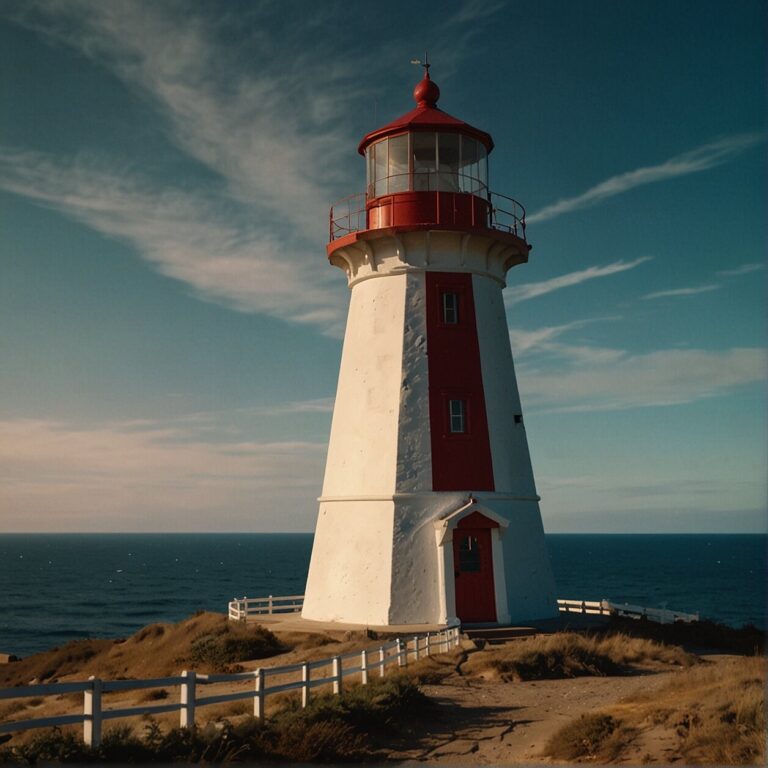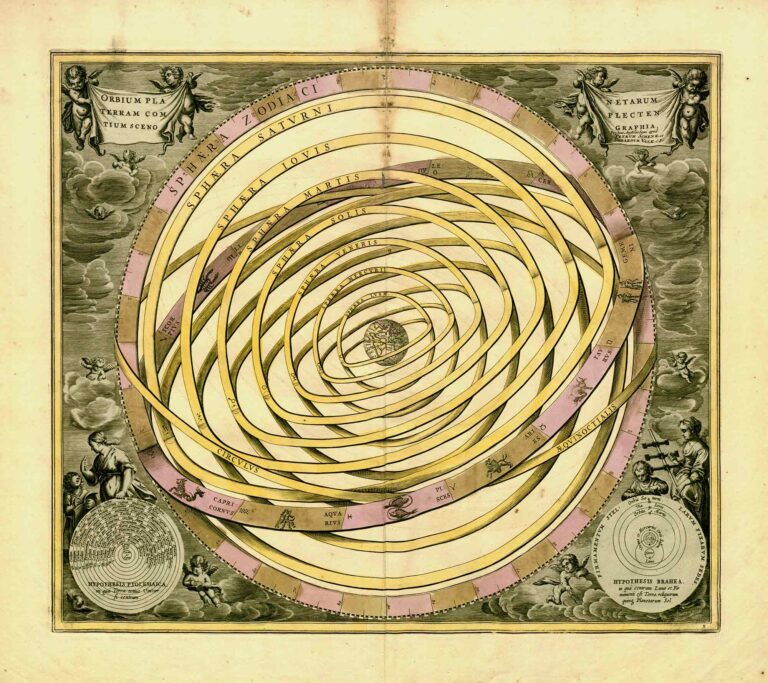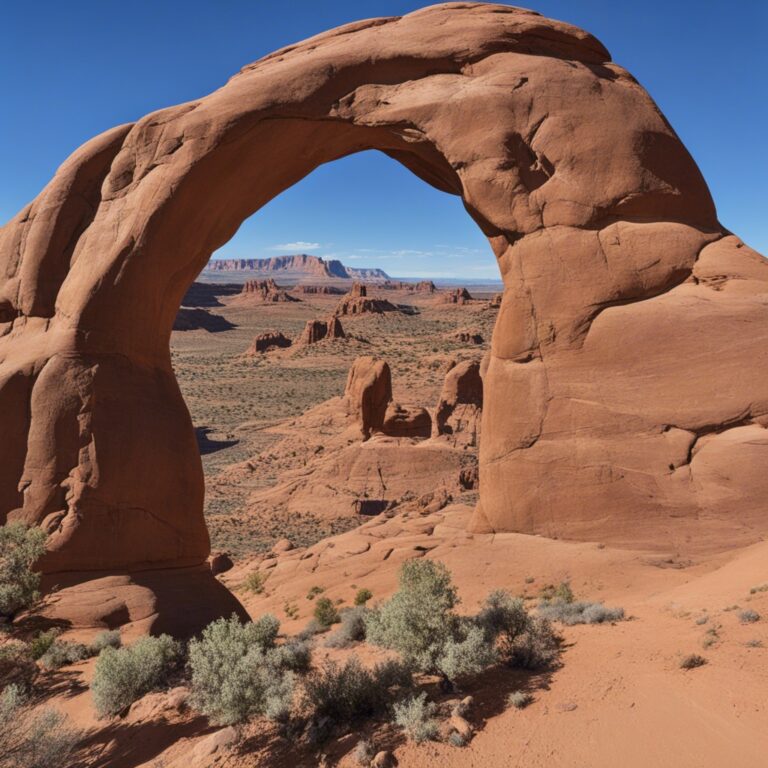Secrets of Navajo Sandpainting in the Southwest USA
Imagine a world where art and religion intertwine, coalescing into a mystical practice that is as visually captivating as it is spiritually significant. Picture a canvas where pure, colored sands breathe life into intricate symbols and figures, each carrying profound meaning and bestowing balance and harmony to the world. Welcome to the mesmerizing world of Navajo Sandpainting, a traditional Native American art form that serves not just as an expression of creativity, but is a gateway to the spiritual realm.
“Navajo Sandpainting goes beyond mere artistic representation. It is a ritual, a ceremony, and essentially a bridge between the human world and the divine. Walking into a room where a sandpainting is being created or displayed, you are invited to palpably experience the spiritual forces of the universe at play.”
You will journey into the sacred world of Navajo Sandpainting, a captivating tradition borne out of the Navajo tribe’s strong spiritual beliefs, anchored in the cosmic duality of order and chaos, of light and darkness. By the end of this enlightening journey, you’ll understand the deep significance each sand grain holds, the pivotal role that sandpainters play in the Navajo society, and how carefully-selected colors symbolize various elements of Navajo cosmology. From its historical roots, the tools embraced for its creation, to the transformative rituals it’s deeply intertwined with – prepare to deepen your appreciation of this unique form of Native American cultural expression.
Unfolding the Mysteries of Navajo Sandpainting
Picture this, you’re stepping into a mystical world beyond the mundane, a world where time and space are compressed to draw upon supernatural healing and assistance. This my friend, is the pipe dream of the Western world, but for the Navajo people – it’s the captivating reality of Sandpainting. It’s this convergence of the spiritual and the material world that lies at the heart of Navajo Sandpainting, an art form like no other.
These vivid paintings, made of nothing more than gently scattered grains of colored sand, are so much more than just attractive art pieces. They’re the beautiful, tactile embodiment of Navajo mythology, intricately weaving together age-old tales, beliefs, and cultural customs in every stroke of sand.
Novice eyes might see these sandpaintings as nothing more than awe-inspiring artwork. But for those who have been fortunate enough to grasp the deep roots of Navajo culture, they realize these paintings hold a potent symbolism. As Deanne Durrett elaborates in ‘American Indian Lives Healers’, Navajo medicine men view these vibrant, complex designs as key elements in healing rituals, drawing upon the chanting of sacred songs to cure patients, all within the artistic landscape created by the sandpainting.
Take the ‘Whirling Log’ sandpainting from the Nightway Ceremony, for instance. The painted icons speak a language more profound than words could ever convey, interpreted by those who understand to tell the stories of the Navajo people. The life-giving Sun, meticulously detailed in the Navajo Sun Sand Painting, signifies the vital energy it imparts, further emphasizing how the world is deeply woven into the culture. In every grain of sand, there’s a story, a belief, an essence of life that the Navajo artists wish to impart. It’s a passage of knowledge, history, and spirituality, narrated without a single spoken word.
Every stroke helps the Navajo people connect to their past and carry forward their profound wisdom. It serves as a constant, tactile reminder of their legacy that moves and evolves in the hands of the artists, yet stays cemented in the lifeline of the culture. Truly, Navajo Sandpainting is an art that speaks from the soul to the soul.
You must’ve heard of the phrase, “Every picture tells a story”. But in the world of Navajo Sandpainting, it goes beyond that. Every painting is a story, each grain a word, the whole composition, a novel – intricate, colorful and soul-stirringly beautiful.
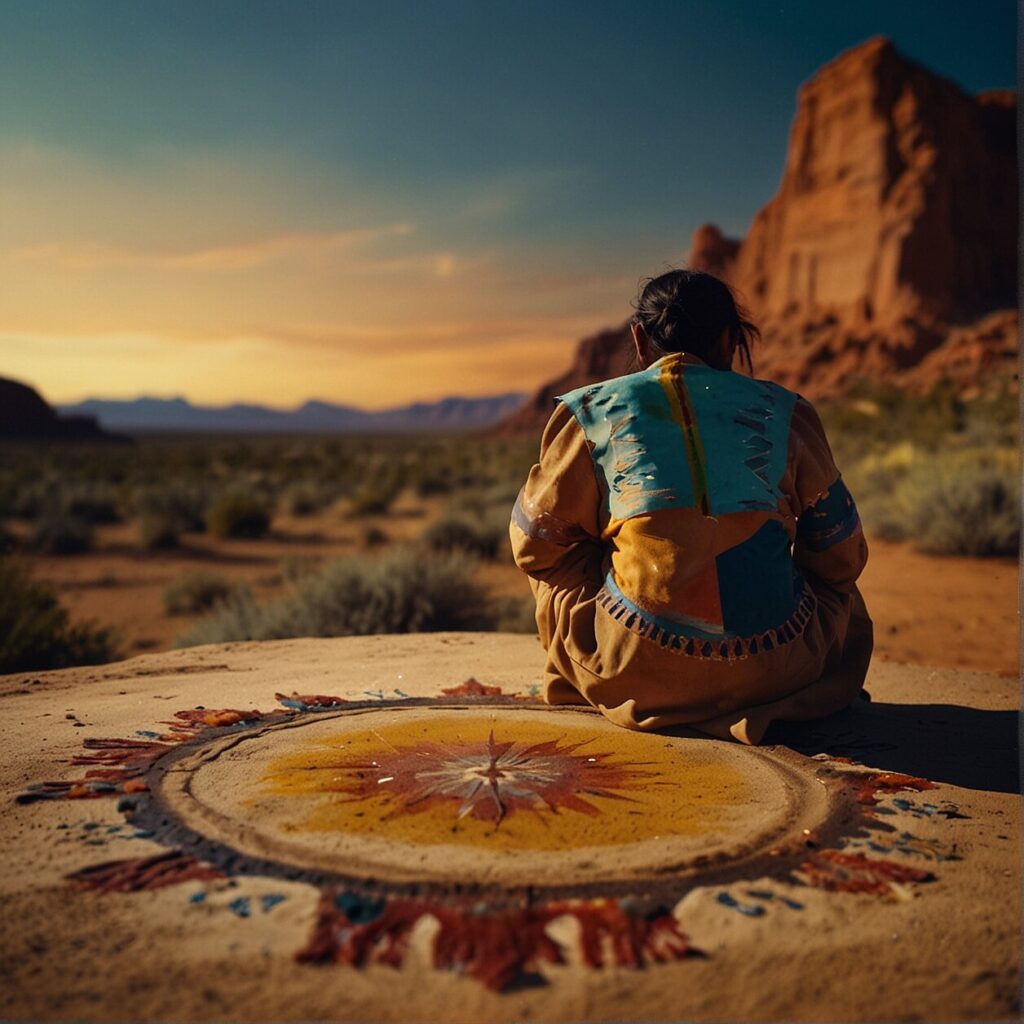
Navajo Sandpainting: The Art of Balance and Harmony
You’ve stepped into the realm of the Navajo, a world pulsating with colors and symbols, where every grain of sand tells a story. The Navajo process of sandpainting is a meditative journey, an artistic ritual, imbued with spiritual significance. It’s an art form like no other.
Imagine for a moment, a canvas made from fine grains of sand. These aren’t just any grains, they’re naturally colored, sourced from sacred locations within the Navajo lands. The artist, oftentimes a Navajo medicine man, carefully places each grain on the canvas, like notes in a symphony, until an intricate picture forms. Each of these pictures is a symbol, a representation of stories deeply rooted in Navajo mythology. Here, art isn’t just about aesthetics; it’s a spiritual bridge, a conduit between the physical and supernatural realms.
Fascinatingly, these aren’t photographs frozen in time. Far from it. Navajo Sandpaintings are believed to possess a unique power, the ability to compress time and space. They enable individuals to tap into a realm beyond our mundane existence, facilitating contact with supernatural forces and yielding profound healing. Deanne Durrett, in her book ‘American Indian Lives Healers’, highlights the way Navajo medicine men utilize these sand paintings and chants fostering an interplay of spirituality and medicine to cure their patients.
One particularly striking motif in Navajo sandpainting features the sun. The life-giving element is often at the center of these sandy canvases, reflecting the Navajo’s deep reverence and connection to nature. Bright yellow, flaming orange, and even shades of red are combined to depict this celestial body, embodying the Navajo’s respect for balance and harmony in the universe.
As you delve deeper into this world of Navajo sandpainting, you’ll not only gain a newfound appreciation for this mesmerizing form of art, but also, you’ll glimpse into the soul of the Navajo culture itself. A culture steeped in spirituality, ritual, and symbology, where art, religion, and healing are intertwined in a dance as old as time itself.
Decoding the Deep Spiritual Significance of Navajo Sandpainting
You’ve no doubt found yourself intrigued by the profound spiritual resonance of Navajo Sandpainting. Now, allow us to further unravel the threads of spirituality weaved into this ancient art form that goes beyond the visual beauty to relay stories of Navajo mythology and tradition.
At its core, a Navajo Sandpainting encapsulates more than just artistic endeavors; it’s a tool to compress time and space, spiraling its viewer into spiritual realms. It’s here you can access supernatural assistance and healing, stepping into an otherworldly dimension where Navajo deities dwell. The belief is that these ethereal beings linger within the intricate patterns, ready to assist in connecting the physical and spiritual realms.
Prominent in these beautiful masterpieces, doesn’t it intrigue your curiosity to know why the principal colors of white, blue, yellow, and black often meet your gaze? Well, let us enlighten you. These colors are not chosen on a whim. Rather, they symbolize the Four Sacred Mountains, an incredibly significant aspect of Navajo beliefs and practices. White represents Mount Blanca to the east, blue, Mount Taylor to the south, yellow, San Francisco Peaks to the west, and lastly, the black symbolizes Mount Hesperus to the north. Each Mountain, each color, holds sacred significance – mirroring the Navajo’s spiritual doings.
Among the many sandpaintings you might encounter, the Whirling Log, a manifestation from the Nightway Ceremony, is one shrouded in deep mystery. The Nightway Ceremony is an intricate healing ritual that stretches over several days. It’s during this event that the Whirling Log sandpainting emerges, symbolizing a Navajo deity’s journey in a whirling log on his mission to restore balance and harmony in the world. No wonder Navajo Sandpaintings are often the centerpiece in healing rites, assisting medicine men in their chants and rituals to bring about recovery.
These artworks, therefore, are more than a confluence of colors and patterns etched on a canvas. They’re a tactile bridge to the divine, a sacred gateway that allows your senses to step into the spiritual landscape of Navajo mythology. As you now understand, every grain of sand sprinkled onto this canvas carries a message, a story, a piece of the divine, ingrained within its minuscule form.
Tools of the Navajo Sandpainter: How It’s All Put Together
Immerse yourself in the world of Navajo sandpainting and you’ll soon begin to appreciate the depth of skill and dedication this form of art requires. It’s not just about creating visually stunning pieces; it’s about preserving and respecting a rich cultural heritage that spans centuries.
Every grain of sand holds significance, each color representing something unique and essential. The process begins with the collection of naturally colored sands from the region. The dedication shows, as every color is derived from nature and meticulously ground to create the perfect texture. Earthy browns from mountain soil, hushed whites from limestone, striking reds from sandstone, and harmonious grays from mixed clay—each echoes the Navajo connection to the natural world. Even blue-green gets a nod, found in the treasured ‘chinde dichil’, a rare, naturally occurring colored sand.
Creating a sand painting requires more than just colored sand though; various tools come into play. These include handmade brushes constructed from yucca leaf strips bound together, and traditional sifters known as ‘yikáádah’. Each grain of sand is meticulously placed, resulting in a spectacular, intricate work of art that’s as breathtaking as it is sacred.
Interestingly, the sand painting isn’t typically preserved. Believed to be a living entity that aids in healing and spiritual connectivity, the painting is often destroyed at the end of the ceremony. This act is a powerful reminder of the ephemeral nature of life, embodying the Navajo belief in the impermanence of all things and the importance of living in harmony with the earth.
Through these tools and the symbolic grains of sand, the artist or medicine man brings the stories of Navajo mythology to life in vivid color and detail, bridging the gap between the mortal and the divine, the mundane and the magical.
The conversation of colors, the dance of designs, the precise tools, and the sacred nature of the process—all these elements converge to give us the unparalleled, intense beauty of Navajo sandpainting. It’s a fine example of how art can transcend mere aesthetics to embody deeper spiritual truths, perfectly epitomizing the base essence of the Navajo culture and its enduring reverence for the divine in every aspect of life.
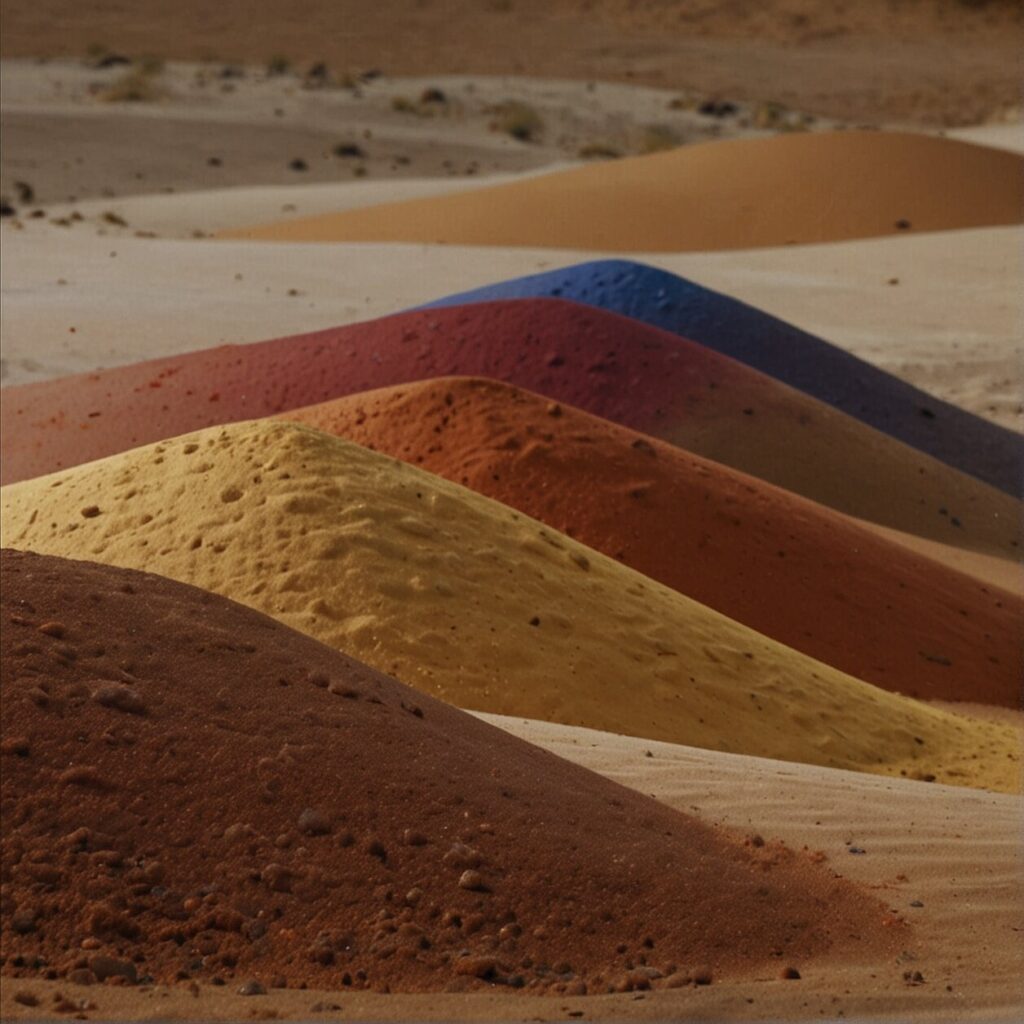
Step-by-Step Process: The Creation of Navajo Sandpaintings
Imagine a palette of brilliantly hued sand, each grain containing its own part of an age-old story, waiting to be artfully arranged on the canvas of Mother Earth. That is the beginning of a Navajo Sandpainting. It embodies a sacred ritual, and the creation process is as important as the resultant artwork. Let’s walk you through the mesmerizing process of creating Navajo Sandpaintings.
The very first step starts with sourcing the sand. Earlier, this vibrant sand was naturally found in the vast expanse of the Navajo landscape. Nowadays, artists opt for commercial pigments, still aiming for colors offered by nature – ochres and umbres, reds, blues, yellows, and whites.
Once the sand is prepared, the artist or the medicine man would plan the layout of the sandpainting, representative of a specific Navajo myth or story. This is often carried out in traditional Navajo dwellings, or ‘hogans,’ adding to the authenticity and spiritual significance of the process.
The sketching of the design starts only after a night of meditative chants and prayers. Navajo tales and myths are intricate, full of symbolism and this complexity is reflected in the drawings. These designs can feature beneficent gods, evil spirits, or detailed scenes from Navajo mythology.
Then comes the grueling process of spreading sand. Working from the center outwards, the sand is meticulously laid on the designated area with the help of bare hands or bird feathers. The process might take hours or even days, depending on the complexity of the design. It is a test of patience, precision, and spiritual dedication.
Unlike other art forms, once the ceremony concludes, the sandpainting is not retained but rather returned to the natural world. This impermanence is a stark reminder of the intrinsic Navajo belief that all is transient in the cycle of life.
Edifying and visually stunning, the creation process of Navajo Sandpainting is not just about creating a work of art, but a spiritual journey that weaves together art, tradition, and mythology, basking in the rich cultural heritage of the Navajo people.
FAQ’S
As we delve deeper into the mystical world of Navajo Sandpainting, you might find yourself bubbling with queries and perhaps a tad bit of curiosity. Don’t worry; it is only natural. After all, the more we learn, the more we realize how much there is to discover! To quench your thirst for knowledge and to clarify some common uncertainties, we’ve assembled a series of Frequently Asked Questions. So, let’s take you further into this captivating realm of ancient lore and artistic magnificence.
What materials are used in Navajo Sandpainting?
Have you ever wondered how the enchanting hues that paint the intricate tales of Navajo Sandpainting come to be? The secret lies in the materials chosen by the artist or medicine man. These include naturally colored grains of sand that present themselves as the canvas onto which the stories of Navajo mythology are brushed.
The pigments that bring these sand grains to life are derived from various natural resources. Drawing on the wealth of the earth, materials such as cedar charcoal lend their essence to create shades of black. Red sandstone contributes its natural crimson. The purity of white is extracted from gypsum, giving contrast to the vibrancy of yellow ochre.
But the story doesn’t end there. Symbolic materials are also used in the process. Pollen and cornmeal, deeply significant in Navajo culture, often find their way into these sacred artworks. Even crushed flower petals are sometimes used, adding a touch of subtle color and a poignant connection to the natural world. The choice of materials goes beyond aesthetic considerations, often imbued with symbolic significance and connected to potent spiritual meanings.
The artist skillfully intertwines these natural pigments to create the Navajo Sandpaintings, aiming not just for visual appeal but also for deeper communication with the divine. So the next time you catch a glimpse of these intricate depictions, remember – every grain of sand, every swathe of color holds a meaning steeped in ancient wisdom and spiritual connectivity.
How are Navajo Sandpaintings used in healing rituals?
Hold on to your fascination as we delve deeper into the spiritual realm of Navajo Sandpainting. Have you ever wondered how they play a pivotal role in healing rituals? To comprehend this, we need to understand how deeply wedded the Navajos are to their beliefs and practices.
The Navajo people use these unique sandpaintings as a type of ceremonial cure, a bridge between the physical world and the spiritual world. Deanne Durrett explains that Navajo medicine men deploy chants and sand paintings in a sublime synchrony to heal their patients. Imagine this incredible scene: the medicine man seeking divine intervention, the rhythm of a chant filling the air, and the gradual emergence of a vivid sandpainting. It’s a mesmerizing sight to behold.
The sandpainting created for each healing ritual is not arbitrary. On the contrary, it represents a specific story from Navajo mythology, chosen carefully by the medicine man according to the patient’s needs. The painting directly links to the ailment it’s meant to cure; it’s a patterned plea for the balance and harmony to return to the afflicted individual.
More than just beauty, these intricate sandpaintings simplify the complexities of the universe. They encapsulate the Navajo belief system, compressing time and space to help individuals connect with the divine. It’s like having a hotline to the heavens via a piece of art!
So next time you come across a Navajo Sandpainting, remember that it’s more than a decoration and deeper than a simple art form. It’s a sacred radar; a means of navigating through the terrain of illness by accessing supernatural assistance. Simply put, it’s a conduit between the seen and unseen worlds. Now, isn’t that something to be marveled at?
Are there different styles or techniques in Navajo Sandpainting?
Absolutely, there are quite a number of techniques and styles that distinguish Navajo Sandpainting, capturing this ancient art’s variety and complexity.
Firstly, it’s important to know that the style of a Navajo Sandpainting can be influenced by its intended purpose. For instance, healing sandpaintings often portray complex deity figures or sacred narratives, crafted meticulously to channel spiritual energies and facilitate healing. On the other hand, those intended for festive ceremonies or constructed purely for aesthetic purposes may feature simpler, more abstract designs.
Additionally, the layout of these sandpaintings plays a key role. Some compositions opt for a linear approach with elements arranged in a row, horizontally or vertically. Other pieces come with an extended-center layout, where the central element is highlighted by an array of interconnected secondary elements. An even more complex style is the radial pattern, where everything emanates or points towards a central, focal point—very much like rays of the sun from mystic Navajo Sun Sand Paintings.
The technique of making these sandpaintings involves careful application of naturally colored sand grains onto a flat surface, often starting with outlining the design before gradually filling in with colored sands. This process varies based on the complexity of the design and the experience of the artis. For instance, seasoned medicine men might choose to freestyle intricate designs straight onto the surface, while novices may prefer to sketch out the conception first.
There’s more to these styles than meets the eye; they are not just arbitrary aesthetic choices but carry symbolic and spiritual weight. For example, the linear layout could symbolize continuity and harmony, while the extended center and radial layouts might illustrate concepts of balance and unity. Every element in these sandpaintings echoes the Navajo’s deep reverence for natural order and balance.
As you can see, Navajo Sandpainting is both an art and a science. Each distinctive style and technique is passionately used in the tricky balancing act of preservation and evolution. So, the next time you view a Navajo Sandpainting, take a moment to appreciate the complex layers of technique, style, and meaning behind each grain of sand.
Is Navajo Sandpainting considered a form of sacred art?
Absolutely, Navajo Sandpainting is revered as a vital form of sacred art. This profound art form stands tall as the cornerstone of Navajo spiritual practice, reverberating with profound religious connotations and deeply entrenched in the heart of Navajo culture.
Navajo Sandpainting, or iikááh as it is termed in the Navajo language, manifests the spiritual map that guides Navajos towards healing and harmony. The intricate designs depict cosmological entities, historical narratives, figurative symbols, and spiritual teachings–all of which bring the viewer into intimate contact with the divine.
Consider this as a bridge, if you will. These elaborate and symbolic sand paintings compress time and space, creating a direct line of communication between the mortal realm and the divine. This art form connects Navajos not only to their ancestors and traditions, but also allows them to tap into the therapeutic energies of the universe.
For Navajo medicine men, or hataalii, the sandpaintings encompass more than mere aesthetics. They are integral to ceremonies and are considered sacred tools of healing. As Deanne Durrett intimates in ‘American Indian Lives Healers’, Navajo sandpaintings are crucial to ritualistic practices and act as visual chants to administer spiritual aid to their patients.
The various colors used have special meanings as well. According to Navajo beliefs, principal colors like white, blue, yellow, and black symbolize the four Sacred Mountains which hold the world in balance. These colors are not arbitrary; rather, they serve to amplify the spiritual resonance of the paintings and encapsulate the multilayered aspects of Navajo cosmology.
In conclusion, Navajo Sandpainting is far more than a beautiful, fleeting art form—it is a symbiotic fusion of art, spirituality, and healing. So, yes, it unquestionably classifies as a transcendent form of sacred art. One that continues to thrive and inspire awe, ensuring the vibrant legacy of Navajo culture remains alive.
Can Navajo Sandpainting be purchased as art?
Well, you might be wondering if it’s possible to own a piece of this beautiful and spiritually significant art. The answer is yes. However, it’s important to make the distinction between religious Navajo Sandpaintings – which are an intimate part of the Navajo spiritual rituals, created and destroyed in the name of healing and balance – and those created for the art market.
Traditional sand paintings for ceremonies are generally not meant to last. Once the ceremonial process is finished, these sacred designs are carefully destroyed, maintaining the respect and integrity of the sacred art form and its spiritual significance. After all, these aren’t simply decorative accessories, but repositories of deep cultural significance, encapsulating millennia of Navajo beliefs and narratives.
On the other hand, Navajo artists do indeed craft sand paintings for sale as art. These are specifically designed to be permanent and are often adaptations of traditional designs, or represent interpretations of the Navajo mythology and culture. Oftentimes, these are created on wood or other lasting materials, using naturally colored sand or other fine materials.
One thing to keep in mind while purchasing Navajo Sandpainting art is that the purchase supports the livelihood of the Navajo artists and contributes to the preservation of their rich cultural heritage. Just ensure that your acquisition is authentic, ethically sourced, and respectful of the Navajo people and their traditions. It’s not just about owning a piece of art but rather, valuing and acknowledging the cultural importance it holds.


